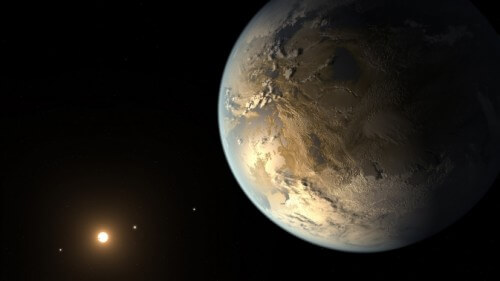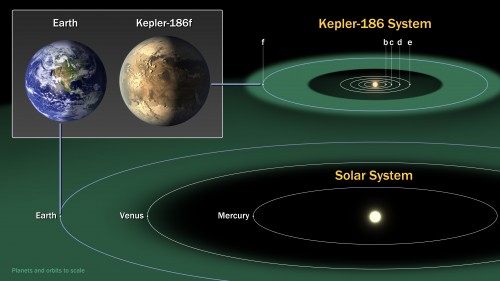Kepler 186f, which is about 10% larger than Earth, orbits together with four other red dwarf planets that is about 500 light years from Earth

Astronomers using the Kepler space telescope have discovered the first Earth-sized planet orbiting its star within the "habitable zone" - the range of distance from the star where liquid water can accumulate on the surface of a planet whose orbit lies within it. Kepler's discovery of 186f confirms the existence of Earth-like planets (in size and ability to support life) outside our solar system. His follow-up lasted for almost three years, due to his relatively long cycle.
Quite a few planets have already been discovered in the habitable zones of their solar system, but the smallest of them so far was 40% larger than Earth and it was difficult to analyze their composition. Kepler 186f is more reminiscent of Earth. It is only about 10% bigger than him.
"The discovery of Kepler 186f is a significant step towards finding worlds similar to Earth" says Paul Hertz, from the Astrophysics Division at NASA Headquarters in Washington. "Future NASA missions, such as the Transiting Exoplanet Survey Satellite and the James Webb Telescope, will discover the rocky planets closest to us and determine their composition and the atmospheric conditions that prevail in them, thus continuing the human search for Earth-like worlds."
Although the size of Kepler 186f is known, its mass and composition are still a mystery. Previous studies indicate that there is a high probability that planets such as Kepler 186f will be rocky.
"We know of one planet where life exists - Earth. When we search for life outside the solar system, we focus on finding planets with characteristics that mimic those of Earth," says Eliza Quintana, a research scientist at the ST Institute at NASA's Ames Center in Moft Yild, California, and the principal investigator of the article published yesterday (the ') in the journal Science. "Discovering a planet in the habitable zone similar in size to Earth is a big step forward."

Kepler 186f orbits the star Kepler 186, which is about 500 light years from Earth in the direction of the Cygnus group. The system is also home to four additional planets, orbiting a star about half the mass and size of the Sun. The star is classified as an M dwarf, or red dwarf, a type of star that makes up about 70% of the Milky Way's star population.
"Since M-type red dwarfs are the most common stars, the highest chance of receiving life signals would be from a planet orbiting such a star," says Quintana.
Kepler 186f orbits its sun once every 130 days and it receives about a third of the energy from its star compared to the energy received by the Earth from the sun. This fact places it near the far end of the life zone. On the ground surface of the planet, the brightness of the main star in the system at noon is similar to that of our Sun an hour before sunset.
"The fact that the planet is in the habitable zone does not mean that we can know for sure that there is life on it. The surface temperature depends on the composition of the planet's atmosphere," says Thomas Barclay, a research scientist at Ames, who deals with environmental studies and is a co-author of the article. "Kepler 186f can be considered a cousin of the Earth more than a twin, it has many features reminiscent of the Earth."
The Kepler planets 186b, 186c, 186d and d186 orbit the star in 4, 7, 13 and 22 days respectively, making them too hot for life as we know it. All four planets are in the mass range of less than 1.5 Earth masses.
The next step in distant life research involves observing true Earth twins - Earth-sized planets orbiting within the habitable zone of a Sun similar to our own, and measuring their chemical composition. The Kepler space telescope, which observed for four years the brightness of over 150 stars, is the first NASA telescope that was able to observe Earth-like planets orbiting suns like our Sun. After the observations are completed, ground-based follow-up observations of each of the planet candidates are needed. Although the telescope stopped focusing on the area of the sky behind the stars it was following due to a malfunction, about XNUMX discoveries of 'candidates' for planets await astronomers who will make ground-based follow-up observations and confirm them finally.
On the fate of the Kepler space telescope: The next incarnation of the Kepler space telescope

13 תגובות
sparrow
I found that when you turn the phone on its side you can see better.
Subject in therapy.
Thank you very much and sorry that I'm digging into a topic unrelated to this article, which by the way is very interesting, but it doesn't work for me because I'm reading it on my mobile during boring holiday meals and not on a desktop computer. The site is indeed optimized for browsing on any device, but apparently some details disappear on devices with a small screen.
If there is another tip I am still interested. Thanks
sparrow,
Press CTRL+F on your keyboard, while you read my response in your favorite browser and paste the inscription in the line below:
April 18 2014
And now go to the article that interests you and look for its date in the same place.
Successfully
To my father Blizovsky
There is no date next to the articles and this makes it very difficult for the credibility of the article. I found an interesting article and I have no idea if it is topical or not
Looking for extraterrestrial life? On other stars?
Go to Be'er Sheva and you will find everything you are looking for!
collect:
It is possible to test the sun's light as it passes through the planet's atmosphere, and from there to analyze the chemical components of the atmosphere (if any), through a method called spectrometry.
If a star has an atmosphere that contains water, oxygen or methane, the chances of life on it increase significantly.
As there is water (clouds) in the Earth's atmosphere, so it is likely that at the temperatures of the planet Kepler 186F there will also be water in the atmosphere, if it exists on the planet itself.
The presence of methane in the atmosphere would be even more significant, because on Earth, methane gas is emitted by living things (although a geological process that produces methane is also possible).
Is there even a possibility to remotely find out if there are lakes there? Or the oxygen in the air?
It's not a red dwarf. It's good, the dwarf.